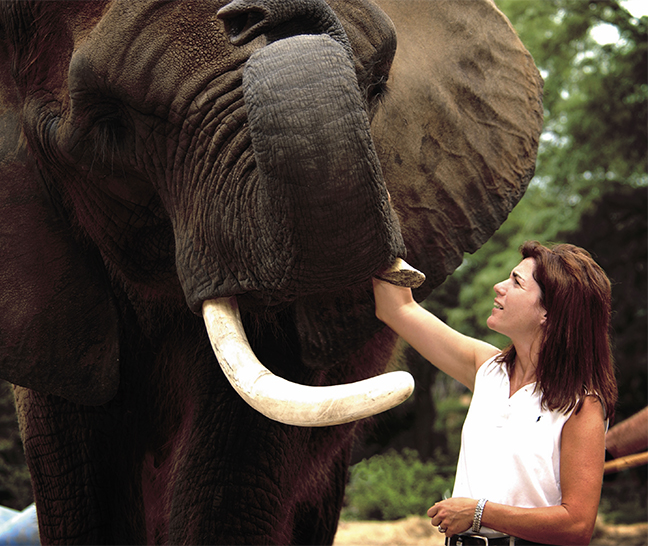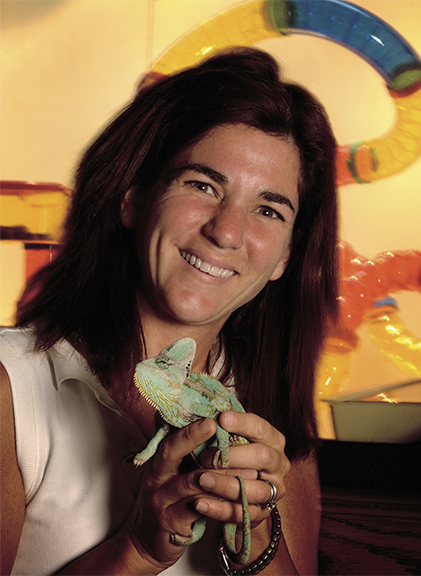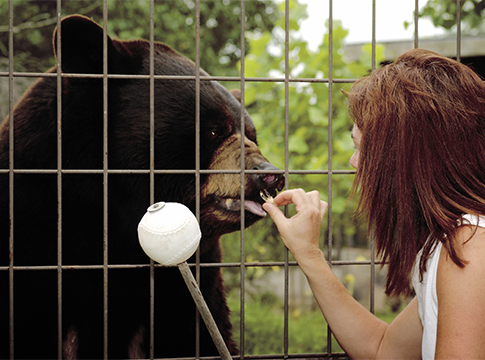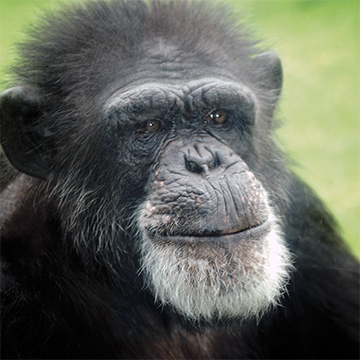
The fabled Doctor Dolittle has nothing on Emily Weiss. The conversations this animal behaviorist has with beasts in every shape and size at the Sedgwick County Zoo enrich their lives, and hers.
As a child growing up in New York, Emily Weiss ’99/00 used to sit on the ground by her parents’ bird feeder, cupping seed in both hands, waiting for the chickadees to come to her. Eventually, she won their trust, and come to her they did.
These days, as curator of behavior and research at the Sedgwick County Zoo, where she focuses on animal enrichment, Weiss is still feeding the animals, but on a much larger scale.
There’s Sula, a beautiful 18-year-old jaguar who, around Weiss, behaves more like a friendly house cat. “Ah,” Weiss says, and Sula opens wide, displaying a mouthful of pearly whites. Weiss trains certain animals, including Sula, with the use of food and a clicker. When the animal obeys a command, a click acts as an auditory signal that a reward is coming. Whether Weiss says “Ah,” “shoulder” or “up,” when Sula acts accordingly, a click lets the cat know a bite of food is on the way.
Teaching the animals such behaviors helps ease their stress during certain interactions with people. A veterinarian giving vaccinations is one example. More generally, the training/enrichment sessions provide the animals with variation in their daily routines. In short, the animals have fun. “We like to keep them active and thinking,” Weiss says.
Sula has been trained to nuzzle her cage with her shoulder and to stand up with the use of the cage. It’s a rather foreboding sight to see such a grand cat upright in all its glory, but Weiss is both comfortable and careful with the jag. In her profession, an error can be costly, so she handles the animals with a healthy dose of respect.
The animals treat her more like an old friend than an average human being, and they’re certainly used to seeing human beings since the zoo averages around 443,000 visitors per year. That number is expected to increase to nearly 500,000 this coming year.
While most visitors gravitate toward the larger animals, like elephants Cinda and Stephanie, among Weiss’ personal favorites are the Aldabra tortoises Rocket and Missy, who aren’t exactly small. At ages 75 and 50, Rocket and Missy have lived out approximately half of their lifespan, since aldabras live to be at least 100. Weiss has a special place in her heart for the smaller of the two, Missy.
“She’s the coolest turtle I’ve ever met in my life,” she says as Missy crunches a carrot. And while turtles and tortoises have a reputation for being slow, a careful observation of Rocket on the move explains why the tortoise really beat the hare. As for being shy, when Weiss is around the tortoises, they rise up out of their shells, which would make them vulnerable in the wild. Weiss explains that this is a sign they are comfortable and at ease with people close to them.

Nearly every animal has its own personality, as in the case of the zoo’s 13 chimpanzees. There’s Bahati, the dominant male; Maisha, the intelligent jokester; and Tammy and Marbles, who were both hand-raised by people and interact more directly with humans than the other chimps. “Marbles was hand-raised by a woman and came to the zoo holding her hand and wearing shoes,” Weiss says. “He also has a foot fetish,” she points out, and a nearby girl immediately steps out of her sandals and places a foot on the glass in front of the chimp, who grins and scampers away.
Unfortunately, chimps can be hard to train — and can indicate their displeasure in what is probably best described as innovative.
The lizards in the new habitrail are, relatively speaking, moving faster than hamsters after a visit to a coffee bar. “Without a doubt, this is our coolest exhibit.”
“There’s poop involved, and they’re very good with their aim,” Weiss explains with a laugh.
While her job may seem ideal to the average animal lover, she acknowledges that a good portion of every workday is comprised of paperwork and meetings. She also conducts research and writes papers on various topics of importance. She is slated to present at an upcoming seminar one of her most recent papers, which describes an improvement to the standard method of collecting rhinoceros semen, so vital for zoo breeding programs. As an animal enrichment expert, Weiss plays a key role in changing how zoos all across the country handle their animal charges.
Rather than merely providing for the basic needs of their residents, zoos have evolved over the past 20 years into more natural places for animals to live out their life cycles. The overall goal has become providing the animals with an environment as closely related to its natural environment as possible.
However, no matter how similar their living quarters may resemble natural habitat, the unavoidable limitations to their movements call for creative remedies before stress and boredom set in. In one of the zoo’s newest exhibits, the South American exhibit, macaws aren’t simply caged and sitting on perches. Instead, they are free-flying and squawk loudly over visitors’ heads as they clutch to a mesh covering designed specially for zoos — and for them.
Animals are concerned with the basics — eating, breeding, hunting and staying alive.
But play also fits into their scheme of things. And helping provide zoo animals with a healthy balance of activities is the primary point of animal enrichment. Becky Kirby, who will be a junior at Wichita State this fall, has been a volunteer at the zoo for five years. She initially got involved through the Zoo Crew, a program designed for teenagers, and now has her sights set on becoming an elephant trainer, which is one of the most dangerous jobs in the United States.
Regardless, she loves working with the elephants and being at the zoo, and enrichment training is a part of what she does. “Each area has what are called enrichment worksheets,” she says. “It’s a great idea that Emily came up with, and there are enrichment calendars so we know what to do with animals and don’t overdo it with them.” In addition to the volunteers at the zoo, the zoo also boasts 13 trainers and keepers who come up with new ways to keep the animals active, and Weiss’ stamp of approval is the final say.
Some areas of animal enrichment pose unique problems, such as breeding. Chewbacca is the zoo’s 17-year-old male orangutan who has never bred. Initially, Blonda, his potential mate, was thought to be the key. “She’s a a bit of a hussy,” Weiss says with a grin. “She’s a little free with the love.”
But the match didn’t work.

black bears. In her profession, an error can be costly.
Despite the danger, she loves her job as the zoo’s
curator of behavior and research.
“Chewbacca was very aggressive with her, and she became stressed. Now we’re working on artificial insemination training,” Weiss explains. Alone in his tree-filled cage, which is littered with play objects, today Chewbacca seems content to sit and watch the visitors and munch away on heads of lettuce. His isolation may strike some visitors as sad, but it’s a natural aspect of orangutan behavior. “Male orangutans live alone,” says Weiss. “He may seem lonely, but that’s part of who he is.”
One noteworthy example of animal enrichment concerns lizards. Weiss and the zoo’s curator of amphibians and reptiles have set up a study in the zoo’s herpetarium where they compare the levels of lizard activity in a “traditional” lizard cage — which is hardly more than a box with food and water inside — to a “new, improved” lizard cage, or habitrail.
This habitrail looks like something out of a 21st-century playground. While the lone lizard in the traditional cage remains stationary, the lizards in the new habitrail are, relatively speaking, moving faster than hamsters after a visit to a coffee bar.
“Without a doubt, this is our coolest exhibit,” Weiss says proudly. “One of the lizards is always doing something.” There are myriad colored tubes and shoots, and a device that resembles a hamster wheel — and the lizards are on the move. Weiss points out that the lizards, like most animals, thrive on variety. This is why the tubes can be taken apart and re-assembled.
Even grizzly bears get in on the animal-enrichment act. Nancy Smith is a senior keeper at the zoo and has been working with the bears for about 10 years. When the bears — Mallory and Devon — see Smith and Weiss coming, they become visibly excited and lumber through their exhibit, out of the view of visitors, and down a long slope leading to a medium-sized water hole. Both Smith and Weiss are some 15 feet above the bears and very safe.
Mallory and Devon not only obey Smith’s verbal commands to stand and paw the air, for instance, but frolic and splash in the water as well.
“They’re incredibly smart,” Smith says. “But just when I think they’re like teddy bears, they’ll have a fight.” Which is the nature of the beast and, as Devon and Mallory are half-brother and sister, part of the nature of sibling rivalry. “They’ve never hurt each other that I’ve seen,” Smith says. “They seem to keep their fighting controlled.” She shakes her head. “But that bellowing they make will make the hair stand up on the back of your neck.”
Weiss and her co-workers have united in common purpose to make the Sedgwick County Zoo a better place for animals to live — whether eating, sleeping, breeding, fighting or playing. Through animal enrichment, the stress and boredom of living in a captive environment are mitigated, and Weiss’ love of animals has resulted in extraordinarily satisfying interactions with all kinds of different creatures.
While visitors to the zoo always seem to have their favorites, Weiss considers all the animals beautiful. She points, as an example, to a Grand Cayman Blue Iguana. “There are only 10 to 25 of them left,” she says. “I think they serve as a symbol. It’s naturally easier to be more sympathetic to a lion than an iguana. But they’re both beautiful, and they both count.
“They all count.”
 The Sedgwick County Zoo
The Sedgwick County Zoo
The Sedgwick County Zoo, the No. 1 outdoor family attraction in Kansas with nearly 450,000 visitors annually, has been ranked among the best zoos in the world since it opened its doors in 1971.
The zoo, which is fully accredited by the American Zoo and Aquarium Association, participates in cooperative Species Survival Plan projects for 28 animal species and is dedicated to the conservation of rare and endangered plants. At 247 acres (that’s roughly 188 football fields), the zoo covers an impressive amount of ground — and the 2,500 animals that call the zoo home appreciate the spacious accommodations.
With exhibits ranging from the Australian Outback to a replicated indoor rain forest, the zoo offers something for everyone.





